 Japan is the world’s third largest car market but it is a difficult one for non-Japanese makers. After a terrible 2011 (earthquake, tsunami), the industry is back in 2012, up 28%. That’s the best performance among developed markets, and is just behind the Middle East car markets, Iceland and Peru. Regular Passenger cars sales (+26%) and kei-cars (+30%) sales contributed to this big jump. Still, compared to 2010 figures (when there wasn’t any disaster or particular event), the growth is moderate: +7,3%. This shows that the market had a fast recovery, wasn’t affected by international financial crisis, and that it is a mature market.
Japan is the world’s third largest car market but it is a difficult one for non-Japanese makers. After a terrible 2011 (earthquake, tsunami), the industry is back in 2012, up 28%. That’s the best performance among developed markets, and is just behind the Middle East car markets, Iceland and Peru. Regular Passenger cars sales (+26%) and kei-cars (+30%) sales contributed to this big jump. Still, compared to 2010 figures (when there wasn’t any disaster or particular event), the growth is moderate: +7,3%. This shows that the market had a fast recovery, wasn’t affected by international financial crisis, and that it is a mature market.
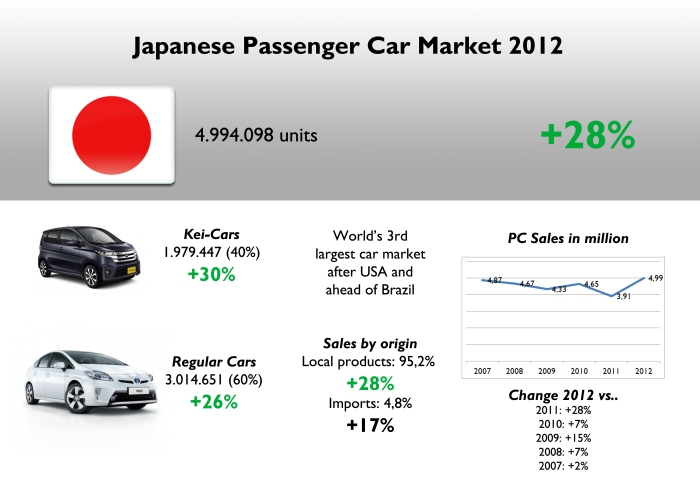
Japanese PC market had an incredible jump in 2012. However it is explained by terrible 2011 results. Compared to 2010 figures the market only grows 7% which is not bad compared to Europe. However the market is still far from 1996 record, when Japanese bought 5,4 million cars. Notice that these numbers don’t include ‘Small’ and ‘Standard’ Trucks, and all types of Buses. Source: JAMA
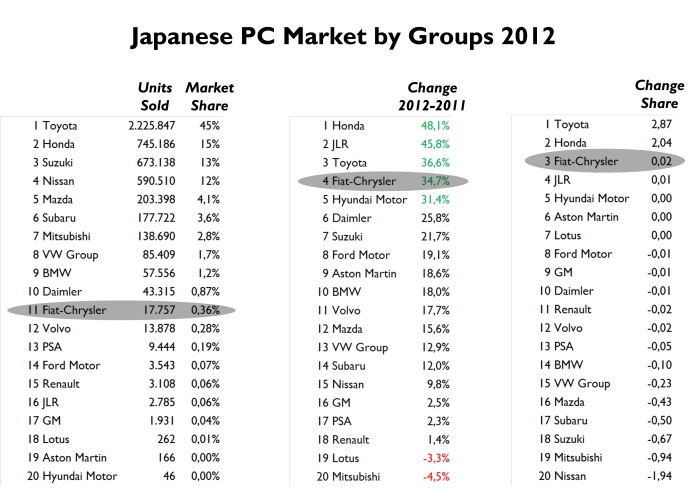
Toyota’s power in Japan is amazing. It controls almost half of the market and sells more or less the same what GM of Ford sell in USA. VW, BMW and Daimler are the best-selling foreign groups but Fiat-Chrysler and Jaguar-Land Rover were the ones with the best change year-on-year. Notice that GM, Ford and Hyundai don’t have any important presence in this market. Source: JAMA, JAIA

Japanese love small cars due to the fact that they are easy to drive in the crowded cities and their TCO is very low compared to regular cars. But they also love Minivans. SUVs are not that appreciated. Source: FGW Data Basis, Best Selling Cars Blog
Japan is well-known for its mini cars, the kei-cars, which have a different regulation regarding taxes and TCO (Total Cost of ownership). This cars, along with other coming from abroad (which doesn’t fulfill local standards but are considered city cars), make part of A-Segment, which counts for a shocking 40%! Therefore, Japan is the largest market for this kind of cars in terms of volume and share. Unfortunately there is no enough data for 2011 figures, so is not possible to analyze the changes in segments. As I said before, the market is really closed even if it doesn’t look. Japan is open for imports from everywhere and some cases there are Zero Import taxes for some cars. Nevertheless, there are many other invisible barriers that difficult the success of imported cars. The result of this policy is evident: 95% of PC sales correspond to locally made models (all of them, Japanese brands). In other words, imported cars are not expensive compared to its Japanese rivals, but the maintenance costs and the price of auto parts are extremely expensive and sometimes difficult to obtain (this problem should be solved once the FTA Europe-Japan is signed).
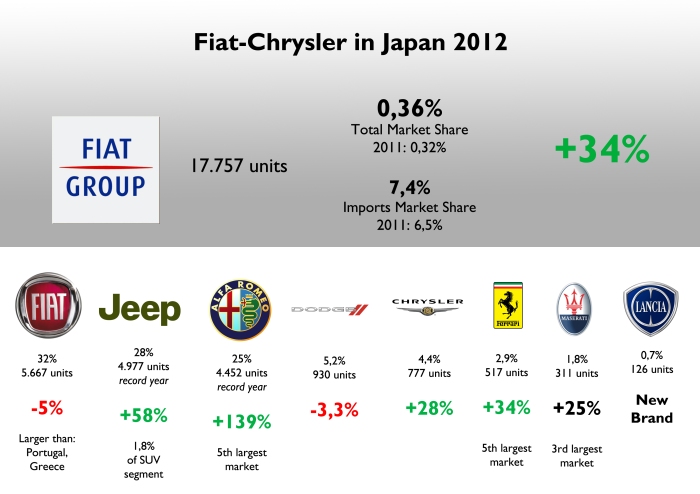
Total sales increased because of Alfa Romeo and Jeep, which had excellent results. Japan is a key market for sporty brands, and some Japanese Lancia models so Fiat decided to begin the official imports. Fiat brand was the 7th best-selling foreign brand and is ahead of Peugeot, Renault, Citroen. Source: JAMA, JAIA
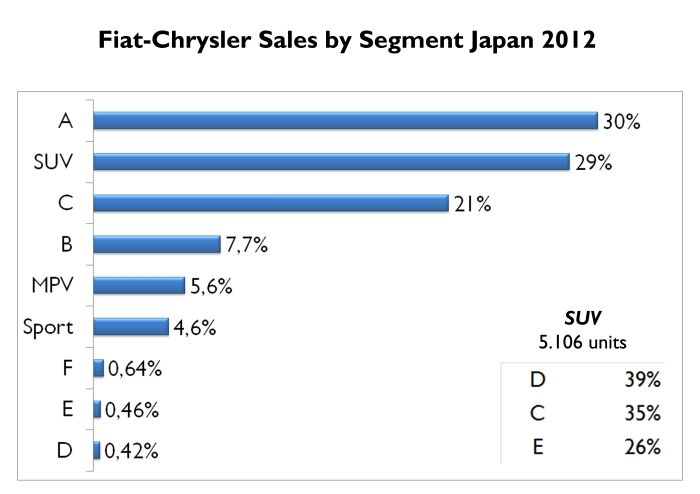
As usual, A-segment is the largest segment for the group. But SUV has also an important position. Notice that B-Segment occupies 4th position after the C-Segment. Source: FGW Data Basis, Best Selling Cars Blog
Fiat-Chrysler has an interesting position in the imports market. Japan is one of the few markets in the world where sales by brands are quite balanced: Fiat brand counts for 32% but is closely followed by Jeep and Alfa Romeo. Ferrari and Maserati had very good numbers (is the third largest market for Maserati and the 5th for Ferrari), while Dodge and Chrysler don’t shine but count for almost 10% of the group’s sales. In 2012 Alfa Romeo introduced the Giulietta and it was an absolute hit, allowing the brand to increase its registrations by 139% (one of the best performances of the brand). Lancia brand was also introduced due to the fact that some Japanese were importing directly the Ypsilon and Delta. However, Lancia is a niche brand. The group’s share in the whole market is very low, 0,36% (which is worse than market share in China and India, but better than Russia’s).
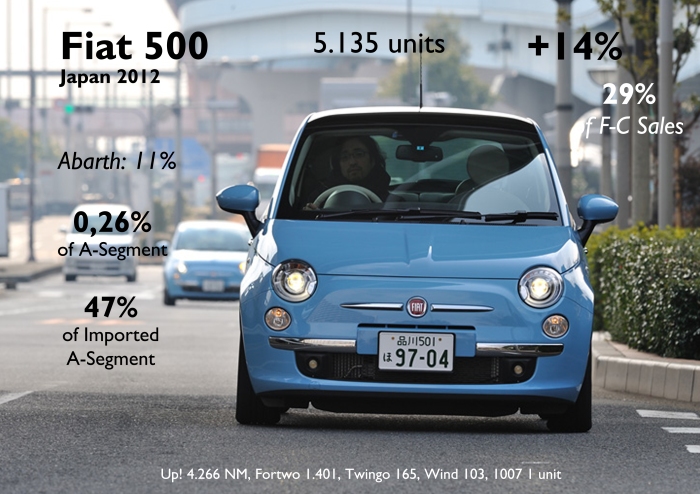
Another good year for the 500 in the land of city cars. Unfortunately, due to its engine and dimensions, it can’t apply to tax benefits of kei-cars. Nevertheless it is the best-selling imported citycar. This year it will have a tough work as the VW Up! is doing very good selling more than 4 thousand units in the last 2 months of 2012. Photo by: njd.jp. Source: FGW Data Basis, Best Selling Cars Blog
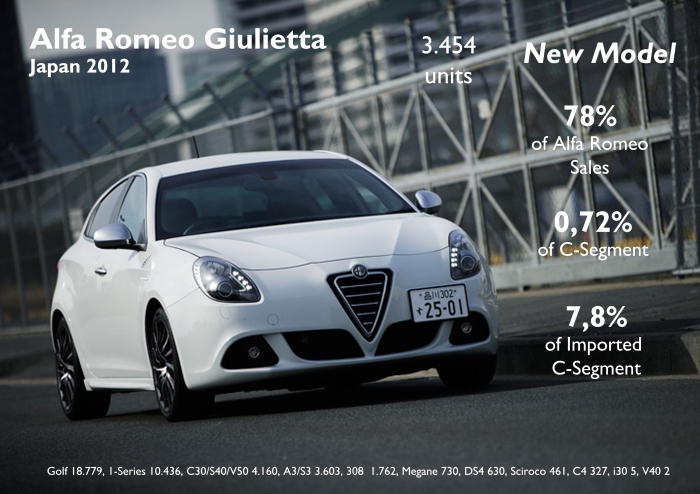
The Giulietta was introduced in January 2012 and it already became the group’s second best-selling car and allowed Alfa Romeo to increase its registrations by 139%. If it wasn’t because of so many invisible trade barriers, this Alfa could have much better sales figures. Source: FGW Data Basis, Best Selling Cars Blog.
Photo by: Carview Japan
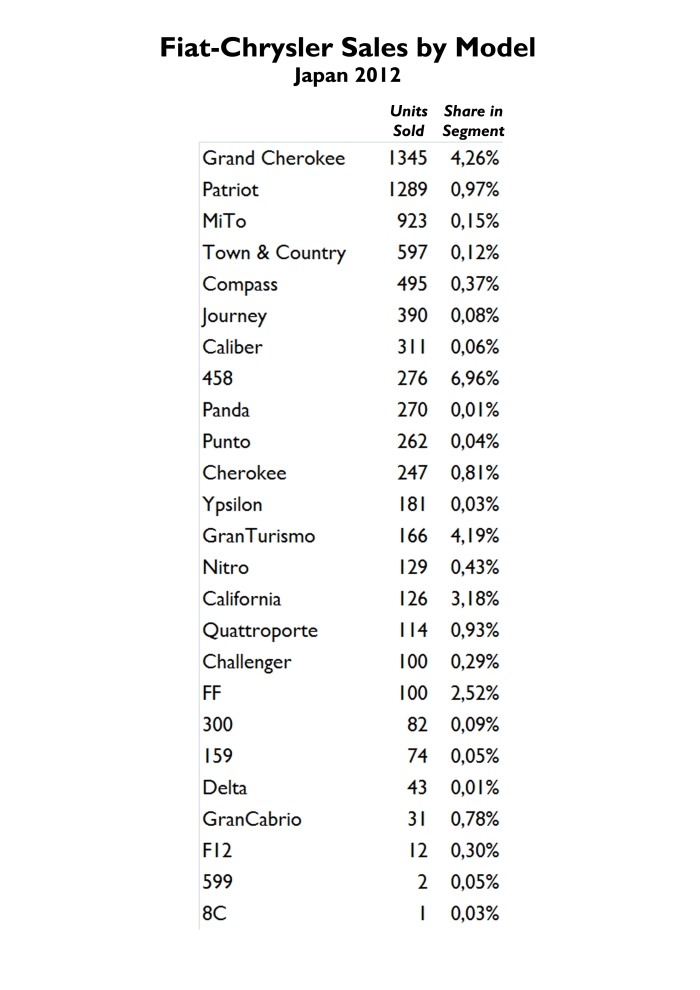
Source: FGW Data Basis, Best Selling Cars Blog



















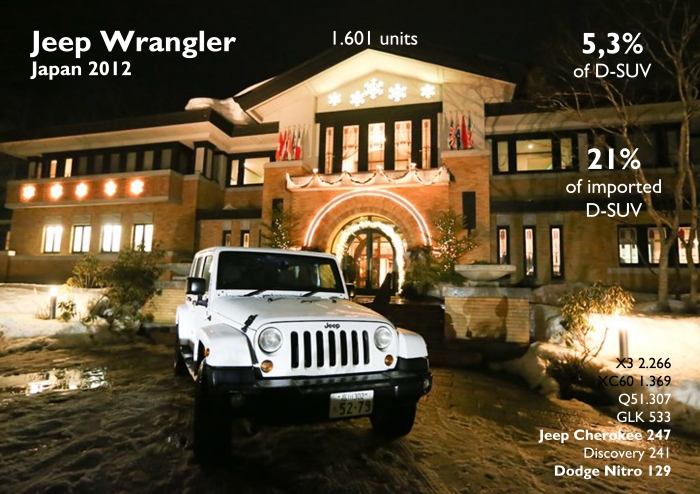
Juan Filipe, what invisible trade barriers are preventing Giulietta sales in Japan? (Apart from consumer preferences and a small dealer network, which really aren’t trade barriers.)
LikeLike
Before selling their cars, Japan requires for alterations to EU-registered vehicles. Besides Japan has its own safety and environmental standards, so getting an approval by Japanese authorities makes their cars more expensive.
LikeLike
The type approval is required for mass imports, yes, but the safety standards are the same UNECE used by the rest of the world.
Anyway, now that the Giulietta is certified and on sale, these should have no impact on the sales performance any more.
LikeLike
I can’t see the Fiat 500 in the above list
Is it me!
Cheers Richard
LikeLike
Hi Richard, The top 3 best-selling models are analyzed in specific charts, just below the list.
LikeLike
Amazing report Juan.
Will you make report by year or montly?
(I’m the brazilian one that replied in the Brazil Market)
LikeLike
I would like to have enough time for montly reports. I will try to make some updates in the next months. Keep reading Brazilian reader!
LikeLike
I will 🙂
Do you have an email for contact?
LikeLike
juanfelipemunoz@hotmail.com
LikeLike
I don’t get. On Chrysler Japan website can see – Chrysler Ypsilon (?)
LikeLike
True!Maybe the’re doing the same as in UK.
LikeLike
http://es.autoblog.com/2012/11/24/chrysler-lanza-en-japon-el-ypsilon-y-compite-con-su-homologo-la/
LikeLike
Hi Juan Felipe, really good job, I like your reports!
I am doing a market research as well and according to the Active Matrix Database System on the JAMA homepage I’ve found a total sales of 4,572,332. The number of regular cars is the same but there are >400.000 Kei-cars in your report. Or the JAMA database doesn’t contain all the Kei-cars? Could you clear up this difference?
Thanks in advance!
LikeLike
Hi Peter. Thanks for your comment.
There were 1,98 million Kei-cars sold in Japan in 2012. There were also 3,39 million non-Kei-cars sold. That’s a total of 5,37 million units. You can check the numbers in Japan Automobile Manufacturers Association, JAMA
http://jamaserv.jama.or.jp/newdb/eng/index.html
LikeLike
Yes, there is a total sales of 5,37 million, but I focus only on passenger cars (like you), and according to JAMA I’ve found a number of 4,57 million.
LikeLike
That’s because you’re not considering the ‘Mini trucks’ which are the Small SUV or Kei-Car SUVs. In 2012 there were sold 1,56 million Kei-Cars and 421k Kei-SUVs. Check out this:
http://jamaserv.jama.or.jp/newdb/eng/sales4/sales4TpMkEntry.html
LikeLike